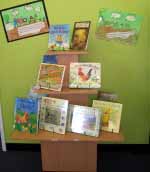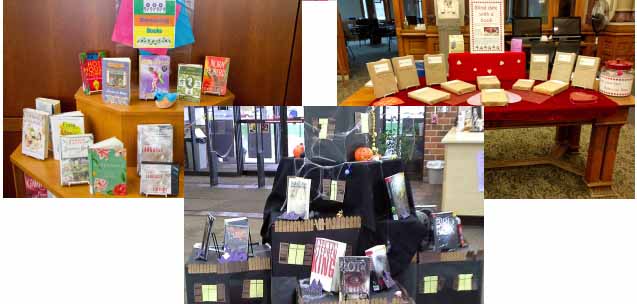Imagine having an extra staff member in your library whose task was to promote, recommend and encourage your library customers to borrow more books. Your displays should work for you, just like having that extra person.
Libraries can use the concepts that visual merchandisers use in retail to design their product displays. Although there is an art to visual merchandising it is also a well-researched science with many strategies that can be easily applied.
Below are 7 tips to creating eye-catching library book displays…

1. What to display
Things like Book Week are certainly a popular display idea. The Children’s Book Council of Australia does an amazing job selecting a theme and fantastic books to go with that theme. But what can you display outside of the main ideas, such as Book Week and special days or events, such as Anzac Day or Christmas….
Why not let pop culture guide some of your displays? Using these types of themes can really help you to resonate with your library users at a time when that topic is popular with them. Find books that are about or are of a similar genre to what’s popular right now.
Some ideas on where to find inspiration; a huge one for the kids – What iPad games are in right now? (who can forget how crazy, popular Pokémon was!) – Or what are they watching on YouTube? – (who doesn’t love a how to make slime clip) Is there a TV program or movie that everyone’s talking about right now? What’s trending on social media? What’s happening on the news? What series books are super popular?
Genre displays – if you don’t already have your library organised into genres you could create displays focusing on a genre. Combine fiction and non-fiction to give your readers a chance to enjoy their favourite genre in story or in facts.

2. Have a Display Toolbox
Some themes may take a bit of thought and resource hunting to put together. But having some display equipment ready to go, can help you if you need to whip up a display quickly.
- Double-Sided tape and Magic Tape
- Book Stands & Easels
- Staplers & Tackers
- Mono filament fishing line
- Signage holders
- Colourful paper and material
- Props (see below for more on this)
Create your own display manual: Take photos of your displays that worked well, take photos of other displays, from Libraries and from retailers and use Pinterest to find display images. This will help you to have an easy reference for when you go looking for ideas on how to do your next display.
3. How to Display
The rule of three: is a guide that artists of all disciplines use to make something visually appealing and eye-catching. Symmetry and balance is pleasant and harmonious to look at but doesn’t grab your attention. When you see something that is asymmetrical you are more likely to stop and look at it. You are also more likely to look at the individual components of a group of items placed asymmetrically. When items are placed in a balanced group they will be seen as a whole and not as individual items.
You can use the rule of three by; placing your display items in groups of three and using three different heights when products are grouped together.
The pyramid principal: uses a triangle (pyramid) design to display items. Your focal point is at the top of the pyramid than the other items “step down” from the top. This is an easy display to do and looks very effective. Using Pyramid Display Stands with book easels mean you can easily create a visually appealing display easily.

Match your displays to your branding: your displays should match the branding you have created in your library and the image you want your library to have. For example, if you have a library that is bright and fun, create your displays with the same sense of fun. If you have a modern, hi-tech library make sure your displays don’t clash with this image
4. Using something more than just books
Having props – an item not for loan but to make the display more visually appealing – can help tell the story of what you are displaying and grab people’s attention to your display. Adding props can also add some texture and colour to your display and visually give it a lift.
Use the right number of props: Be careful not to overdo props as then the display becomes about the props and not the books. This may make people feel like they are not meant to take the books from your display. Try to limit your props to only one or two. The books are what you want people to notice and what you want them to borrow.

Novelty: the prop doesn’t always need to ‘match’ the display. Our brains are wired to seek the unusual so having something that is a surprise can draw attention to your display. You could also have the prop appear in an usual position, i.e. upside-down.
5. Signage
Make sure that your signage lets people know they are supposed to take the books. Sometimes people may not want to take books from a display, give them permission to take items. An example might be ‘Grab a book on….’
Make your signage simple and easy to understand;
- Visibility: if signage blends in to well with your display then it won’t be seen. Use contrasting colours and place signs where they will be seen.
- Quantity: Don’t use too many signs or more than one message per sign. If there are too many signs they will be ignored. Try to use as few words as possible.
- Readability:
- Use legible fonts. Sans-Serif fonts are easy to read on signs.
- Capital and lower-case letters together are easier to read than ALL CAPS.
- Use colours with the highest contrast. If the background and font colours don’t have a high contrast it can make it difficult to read.
6. Keep Things Moving
With all the sensory information our brains take in we use attention filters to only consciously received the information we need at the time. When your displays are always in the same location our attention filters can stop noticing the displays. Moving the displays around the library can help create novelty to the display and re-capture people who use the library regularly.
7. Use Your Shelving for Displays
Long rows of books, spine out can also mean that people switch off to what is in-front of them. Display shelves scattered among your flat shelves can work well. But, if you don’t have enough room or don’t have display shelves you can use book stands and easels in the gaps on the shelves to turn a book front facing.

